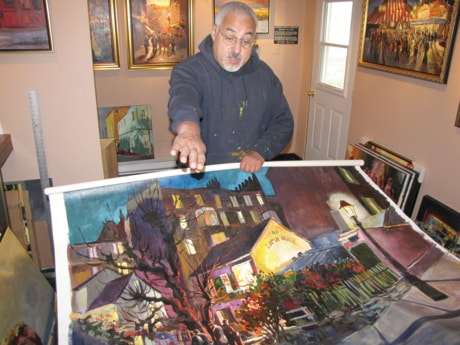BAIE ST. PAUL, Que. — Some folks will tell you, sometimes with a twinkle in their eye and sometimes with a straight face, that it’s the meteor that thundered into the river and mountains northeast of Quebec City millions of years ago that gives this area its distinctive feel.
Others swear that something about the interplay of gentle green mountains and the salty air of the broad St. Lawrence is responsible for the serenity and light of the Charlevoix region.
They talk about Paris as the city of light, but painters have been hauling their easels around this part of Quebec for decades as they try to capture the remarkable patina that seems to descend on this pastoral section of the province.
A visitor from Texas was standing on a golf course not far from the St. Lawrence River on a brilliant late summer day when he remarked on how the clothes that a group of players on a nearby hole were wearing looked so vivid.
He was right. Late afternoon can be a spectacular time of day anywhere in the world, but looking at the crisp colours that the other players were wearing was startling. It was as if you’d taken someone who’d been watching a scratchy movie on VHS and suddenly flicked the switch on a Blu-ray disc.
While much of the St. Lawrence shoreline northeast of Quebec City is lined with cliffs, the area near Baie St. Paul and up toward La Malbaie sits in a large, bowl-shaped depression that was created when the giant meteor — estimated at 15 billion tonnes — hurtled through Earth’s atmosphere and created an enormous valley, one that is now a UNESCO-protected world biosphere.
You can shop in Baie St. Paul for meteor-related souvenirs if that’s your cup of Darjeeling, but most folks who come this far past Quebec City do so to check out the quaint shops and inns and the galleries, which run the gamut from Group of Seven-style scenes of towering birch and pine trees, to galvanized metal sculptures and modern silk-screens.
Baie St. Paul is said to have more galleries per square kilometre than any town in Canada. There are some two dozen scattered about a town that has plenty of down-home charm and has, so far, resisted the temptation to get overly precious.
Outside of town, between Baie St. Paul and La Malbaie, you might find Humberto Pinochet working on one of his paintings, which look like bold versions of Impressionist work to an unschooled observer: lots of bold colours but not too definitive.
Pinochet, whose work can sometimes be found at Brights’ Gallery in Collingwood, Ont., and Win Henstock in Oakville, Ont., calls himself “a light hunter.”
“I’m always trying to find places with a nice expression of nature,” he says. “You come over the hill to Baie St. Paul and you see the landscape, it’s something very strong. It’s always changing; like music.”
Augusto Pinochet was a Chilean dictator who is said to have ordered thousands of people tortured or killed. But Humberto is reluctant to talk about his background, telling a visitor his name is French and that his relatives came from Brittany.
His brother, a Charlevoix artist named Cristobal, has a website that says Cristobal was born in Chile and that his father, Jorge, was an art dealer. Other biographies on the web say Jorge Pinochet was a supporter of overthrown Chilean Marxist leader Salvador Allende and that the family fled to the safety of Quebec in the mid-1970s.
Folks in Charlevoix merely shrug and mumble that their Pinochets “are from the good side of the family,” which seems to be borne out by the reports. Whatever the story, Humberto is a renowned artist who has established himself in Charlevoix. His brother has a gallery just up the road and his mother, Sylvia Araya, has a gallery in Baie St. Paul.
If art isn’t your thing you can find plenty of action at the casino next to the Fairmont Le Manoir Richelieu outside La Malbaie, a stately hotel with lovely gardens and broad pathways that provide stunning views of the St. Lawrence, which is mostly salt water this far east.
Christopher Spear, who previously served as director of sales and marketing at the hotel, explained that the area first became popular with rich Americans from New York and Boston. Among those who made the annual sojourn north to cooler climes was former U.S. president William Howard Taft.
Taft is said to have once remarked that the air around La Malbaie was “as intoxicating as Champagne, yet without the hangover.”
The golf at Le Manoir Richelieu offers great conditions and superb views. There are also programs for visitors of all ages and snowmobiling or cross-country skiing in winter. Le Massif ski resort is only 45 minutes away.
You also can check out the whale-watching on the St. Lawrence or make the half-hour trek north of La Malbaie to the stunning Parc national des Hautes-Gorges-de-la-Riviere-Malbaie, where you can take a narrated boat ride past towering cliffs or set your own pace in a canoe or kayak and float silently past the humbling mountains.
Tour guides often spot moose or deer or eagles. One enthusiastic guide constantly points to rock formations on the cliffs that he swears look like a monkey or, in one case, Adolf Hitler. It was a little hard to conjure up what he was seeing, but if you drove up and down the same river three or four times a day for a few years you’d probably start seeing things, too.
There’s plenty to do in La Malbaie, especially with the casino next door. But it’s not exactly Rue Crescent at night.
“I sometimes tell people I’m going to the city for lunch when I’m driving to Baie St. Paul,” Spear said. “There are 8,000 people in Baie St. Paul. It has 1,000 more people than La Malbaie. And one more grocery store.”
